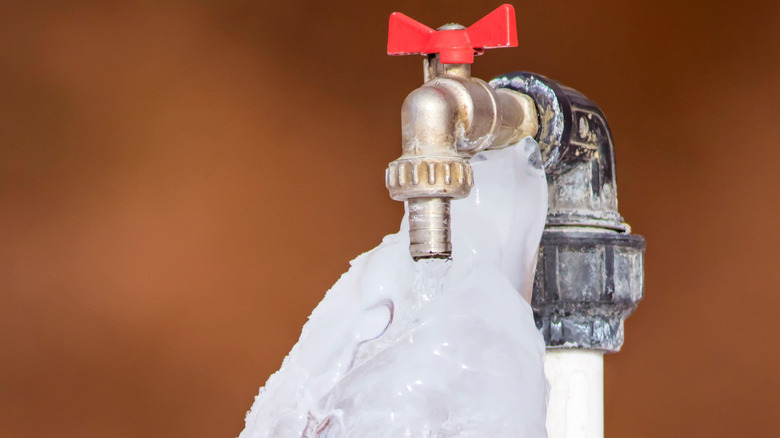Ways to Avoid Frozen Pipes in Cold Weather: Pro Tips
Ways to Avoid Frozen Pipes in Cold Weather: Pro Tips
Blog Article
This post directly below pertaining to Prevent Frozen Pipes is amazingly fascinating. You should investigate it.

Cold weather can wreak havoc on your pipes, especially by freezing pipelines. Right here's how to avoid it from taking place and what to do if it does.
Introduction
As temperatures drop, the danger of frozen pipes increases, potentially bring about costly repair services and water damage. Recognizing how to prevent icy pipelines is vital for home owners in cold environments.
Recognizing Frozen Pipelines
What triggers pipes to freeze?
Pipelines freeze when subjected to temperature levels below 32 ° F (0 ° C) for extended durations. As water inside the pipelines ices up, it expands, putting pressure on the pipeline wall surfaces and potentially creating them to rupture.
Risks and damages
Icy pipes can result in water system disturbances, property damages, and expensive repair work. Burst pipelines can flood homes and cause comprehensive structural damages.
Indications of Frozen Water Lines
Identifying frozen pipelines early can prevent them from bursting.
How to identify icy pipes
Seek reduced water circulation from taps, unusual smells or sounds from pipes, and visible frost on subjected pipes.
Avoidance Tips
Protecting susceptible pipes
Cover pipes in insulation sleeves or utilize heat tape to secure them from freezing temperatures. Concentrate on pipelines in unheated or external locations of the home.
Heating strategies
Keep indoor areas sufficiently heated, particularly locations with plumbing. Open up cabinet doors to permit cozy air to distribute around pipes under sinks.
Securing Exterior Plumbing
Garden hoses and exterior taps
Separate and drain pipes garden tubes before winter. Set up frost-proof faucets or cover outdoor faucets with insulated caps.
What to Do If Your Pipes Freeze
Immediate actions to take
If you presume frozen pipes, keep faucets available to soothe pressure as the ice thaws. Make use of a hairdryer or towels taken in warm water to thaw pipes gradually.
Long-Term Solutions
Architectural modifications
Think about rerouting pipes away from exterior wall surfaces or unheated locations. Add added insulation to attics, basements, and crawl spaces.
Updating insulation
Purchase top quality insulation for pipelines, attic rooms, and wall surfaces. Proper insulation helps maintain constant temperature levels and reduces the danger of frozen pipes.
Verdict
Protecting against icy pipes needs positive actions and fast feedbacks. By comprehending the reasons, signs, and safety nets, house owners can secure their plumbing during winter.
5 Ways to Prevent Frozen Pipes
Drain Outdoor Faucets and Disconnect Hoses
First, close the shut-off valve that controls the flow of water in the pipe to your outdoor faucet. Then, head outside to disconnect and drain your hose and open the outdoor faucet to allow the water to completely drain out of the line. Turn off the faucet when done. Finally, head back to the shut-off valve and drain the remaining water inside the pipe into a bucket or container. Additionally, if you have a home irrigation system, you should consider hiring an expert to clear the system of water each year.
Insulate Pipes
One of the best and most cost-effective methods for preventing frozen water pipes is to wrap your pipes with insulation. This is especially important for areas in your home that aren’t exposed to heat, such as an attic. We suggest using foam sleeves, which can typically be found at your local hardware store.
Keep Heat Running at 65
Your pipes are located inside your walls, and the temperature there is much colder than the rest of the house. To prevent your pipes from freezing, The Insurance Information Institute suggests that you keep your home heated to at least 65 degrees, even when traveling. You may want to invest in smart devices that can keep an eye on the temperature in your home while you’re away.
Leave Water Dripping
Moving water — even a small trickle — can prevent ice from forming inside your pipes. When freezing temps are imminent, start a drip of water from all faucets that serve exposed pipes. Leaving a few faucets running will also help relieve pressure inside the pipes and help prevent a rupture if the water inside freezes.
Open Cupboard Doors
Warm your kitchen and bathroom pipes by opening cupboards and vanities. You should also leave your interior doors ajar to help warm air circulate evenly throughout your home.

Hopefully you enjoyed reading our topic about Helpful Tips to Prevent Frozen Pipes this Winter. Thank you for taking a few minutes to read through our article post. Sharing is good. Helping others is fun. Thanks a lot for going through it.
Book Appointment Report this page